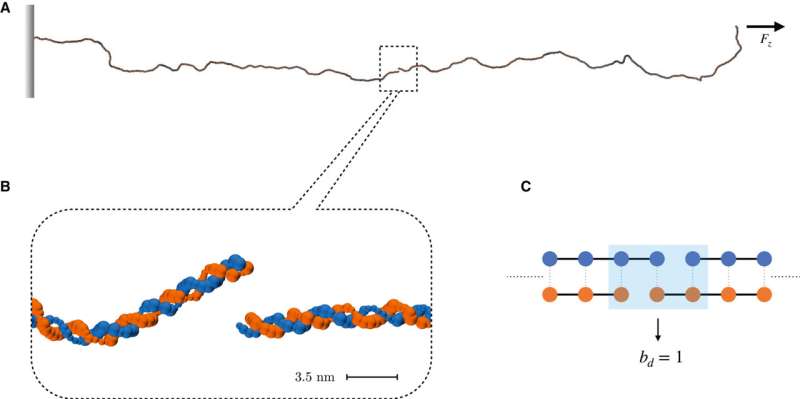This article has been reviewed according to Science X's editorial process and policies. Editors have highlighted the following attributes while ensuring the content's credibility:
fact-checked
peer-reviewed publication
proofread
The link between the impact of radiation on DNA and the time in which the damaged molecule breaks irreversibly revealed

We are exposed to ionizing radiation more often than we think: when we bathe in the sun, which emits UV rays, or when we get X-rayed. Even when we are traveling on an intercontinental flight, which reaches 10,000 meters above sea level. This type of radiation is potentially harmful for DNA because it can damage it, break its structure or modify it, leading to the formation of tumors.
A group of scientists led by Raffaello Potestio and including Manuel Micheloni, Lorenzo Petrolli and Gianluca Lattanzi investigated the rupture of DNA that has been affected by ionizing radiation. They calculated the mean time between the exposure to radiation and the rupture of the DNA strand. And they found that the more the distance between damaged areas of DNA, the longer the DNA structure stays together. This, as a result, gives the cell more time to repair the damage. The paper is published in the Biophysical Journal.
Computational models
The researchers created a computer simulation of a double-stranded DNA sequence, as in a sort of video game. They mimicked radiation damage on the filament and observed its behavior. One of the most dangerous consequences of the impact of radiation on DNA is the rupture known as double-strand break (DSB), that is the interruption of the structural and chemical continuity of the DNA skeleton in the two complementary strands.
This type of injury can lead to serious consequences at the cellular level. Scientists have understood that the strands do not break immediately and that the time it takes for a strand to break increases exponentially with the distance between the breaks in the DNA strands. The authors of the work managed to formulate a law for average rupture times based on the distance between the strand breaks. "This information is crucial—emphasizes Raffaello Potestio—because it probably affects the effectiveness of DNA repair processes."
Rupture time and repair time
Cells have a complex enzymatic system for the control and "maintenance" of DNA, which is triggered when it receives signals of injury. This mechanism, however, is not triggered immediately after the damage, and a delay can affect the normal functioning of the cell. Sequence modification may not be impactful if it occurs via one or more synonymous mutations, which result in the synthesis of the same protein.
However, if there are substantial changes in the DNA sequence or errors in the repair process, in the best case scenario the cell commits suicide (a process called "apoptosis"), because it realizes that the sequence is incorrect or irreparably damaged. In the worst case scenario, on the other hand, the cell restores the integrity of the DNA chain but this can cause a mutation, or a change in of the nucleotide sequence, that could lead to dysfunctional behavior and hence to genetic modifications, chromosomal mutations or the onset of cancer.
From computers simulation to practice
The authors of the study believe that this work is significant for the radiobiological sector and represents a first step towards possible developments in medical treatment and prevention. This study stands out for the use of numerical simulation techniques that could be experimentally reproduced: transferring the simulation from the computer to the laboratory is one of the objectives of the researchers.
Understanding what happens when DNA is damaged by radiation opens the way, in the long term, to new and increasingly precise radiotherapeutic treatments. "This study has a dual and complementary purpose—explains Potestio.
On the one hand, to understand the mechanisms that cause cellular damage to prevent or limit such damage and, on the other, to find the best way to cause the greatest possible damage. This is important, for example, in the field of proton therapy, which uses ionizing radiation, specifically protons, to target cancer cells and kill them."
"Radiotherapy—he continues—encompasses a series of more complex issues such as, for example, precisely locating the radiation deposited in cancer tissues, so as to prevent the rays from targeting healthy cells that could be damaged. The more we understand the consequences of radiation and the rupture of DNA strands, the more we'll be prepared to develop other treatments and mitigate side effects," concludes Potestio.
More information: Manuel Micheloni et al, Kinetics of radiation-induced DNA double-strand breaks through coarse-grained simulations, Biophysical Journal (2023). DOI: 10.1016/j.bpj.2023.07.008
Journal information: Biophysical Journal
Provided by Università di Trento




















